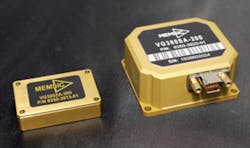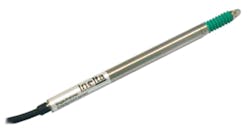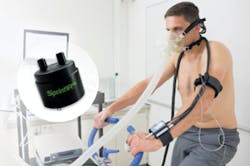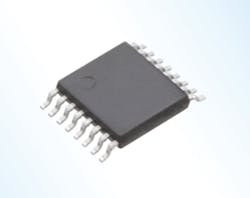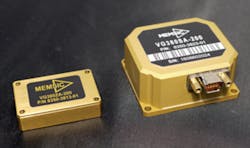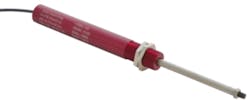This product focus looks at some sensors introduced since our last examination of the category.1 You’ll find position, speed, and angle sensors as well as a gyro module. In addition, you’ll see a liquid sensor that can protect telecom equipment from leaks. “The impact of leaks on networking equipment can be heavy, with the consequential downtime being harmful to the telecom company’s reputation and raising frustration for their subscribers,” explained Paddy Shannon, technical director at SST Sensing. “The implementation of our Optomax devices in this scenario is proving increasingly popular. Through only minimal investment, the ongoing functional integrity of vital telecom hardware can be assured.”
You’ll also find a CO2 sensor that can be used in fitness testing, breath analysis, capnography, sports science, and veterinary medicine. Ralph Weir, CEO at Gas Sensing Solutions, explained, “We are the only company producing CO2 sensors using LEDs and photodiodes, and as we make the LEDs and photodiodes ourselves, we have been able to develop ultrafast response times that no other NDIR [nondispersive infrared] sensor can match. Typical NDIR CO2 detectors take several seconds or even minutes to take a reading because they use slow-reacting IR sources, which need time and energy to warm up, like MEMS hotplates, micro-bulbs, or filament-based micro-lamp technologies. Our LEDs, by contrast, are solid-state emitters and illuminate almost instantly. With the new SprintIR6S, we’ve also minimized the sample volume down to only 2 ml, which enables us to achieve our fastest ever response rates.”
They also can serve in health and safety applications. Weir notes that a leak from a CO2 canister can push CO2 levels up from the normal 400 ppm to several thousand ppm. “You cannot smell CO2, and it is colorless,” he said. “Yet it can present serious health problems at raised concentrations, so the sooner an alarm is raised, the sooner people can take remedial action.”
Reference
Nelson, R., “Sensors Expo offers gamut from components to networks,” EE-Evaluation Engineering, May 2017, p. 24.
ILAT Series miniature LVDT sensors provide precision measurements of position and path in the single-digit-millimeter range. The sensors include Models ILAT2, ILAT4, and ILAT10 for the measurements of ±1-mm, ±2-mm, or ±5-mm traveling distances. Owing to their dimensions with a housing length of 79 mm and a diameter of 8 mm at a weight of 30 g (including cable), the sensors can navigate within tight-fitting conditions. The ILAT sensors operate free from wear and provide a linearity tolerance of <0.25% or optionally <0.1%.
They come in a stainless-steel housing in protection class IP65 (optionally in IP67). Nominal temperature rating is 0° to 70°C, and the probe and can provide more than 10 million cycles. The sensors are suitable for applications including medical technology, engineering, agriculture, and navigation.
Fitting the ILAT path sensors are external sensor amplifiers available for signals in the ranges of 0 to 5 V, 0 to 10 V, ±5 V, ±10 V, and 0 or 4 to 20 mA. Inelta, the manufacturer, can provide custom sensor designs with further optional features such as custom-made cable lengths and expanded temperature ranges. Available through Hoffmann + Krippner
Liquid sensors
To help telecom companies guard against the threat of rainwater ingress, a series of leak-detection sensors, based on proprietary Optomax technology, has been developed. These liquid-level switch devices don’t have moving parts. Instead they utilize an infrared sensing mechanism. If a liquid comes into contact with the sensor tip, it will change the properties of the optical setup with light that previously was internally reflected being dispersed. Less light is thus incident on the device’s phototransistor, leading to change in the output voltage.
The Optomax devices are available in an M10 housing with a length of 22.7 mm. Supporting a working temperature range of -25°C to +80°C, these units can deal with severe fluctuations in environmental conditions and maintain long-term operation. SST Sensing
The SprintIR6S employs the vendor’s SmartIR technology to enable the new sensor to take up to 20 CO2 readings per second—a six-times-faster response rate than the current SprintIR, the vendor reports. SmartIR technology detects the presence of CO2 by detecting how much light is absorbed by CO2 molecules as light passes through the sample gases. CO2 absorbs between 4.2 and 4.4 microns so that its presence is easily detected, and the amount of light absorbed indicates how much CO2 is present.
Typically, CO2 detectors use a miniature heater to generate a range of wavelengths that have to be filtered down to the wavelengths needed, which is wasteful and energy inefficient, especially as a lot of heat is produced. By contrast, GSS developed commercial, mid-range IR LEDs are tuned to emit just at 4.2 to 4.4 microns, making them energy-efficient. A single lithium cell can power a SmartIR sensor for up to 10 years.
At less than a cubic inch (23.8 mm in diameter and 24 mm tall), the SprintIR6S operates at between 3.25 V and 5.5 V, with a power consumption of 35 mW. The SprintIR6S is available in measurement ranges from 0% to 100%. Gas Sensing Solutions
Speed and direction sensor IC
A new optimized Hall-effect integrated circuit and rare-earth pellet combination provides a user-friendly solution for direction detection and true zero-speed, digital gear-tooth sensing. The small package can be easily assembled and used in conjunction with a variety of gear-tooth-sensing applications. This new IC employs patented algorithms for the operational requirements of automotive-transmission and recreational-vehicle applications. It also is compatible with nonautomotive applications found in white goods as well as exercise and industrial equipment.
The speed and direction of the target are communicated through a variable pulse-width output protocol. The ATS699 is adept at handling vibration without sacrificing maximum air gap capability or creating any erroneous “direction” pulses. Even higher angular vibration caused by engine cranking is rejected by the device. The advanced vibration detection algorithm will systematically calibrate the sensor IC on the initial teeth of true target rotation and not on vibration, always guaranteeing an accurate signal in running mode. Allegro MicroSystems
The TAD2141 TMR (tunnel magneto resistance) angle sensor with digital output offers a guaranteed accuracy of ±0.2° and at room temperature achieves an angle error of only ±0.05° when an automatic correction function is activated. The sensor is capable of contactless sensing over 360 degrees within a temperature range of -40°C to +150°C. Furthermore, the new TAD2141 sensor represents a level of miniaturization and weight-saving in comparison with conventional solutions using resolvers. Engineering samples of TAD2141 are available while certifications according to ISO 26262 and ASIL are under preparation.
The automatic correction function available with the TAD2141 reduces the design-in effort. Moreover, the new angle sensor is equipped with a self-diagnostic function that detects not only an abnormality in the sensor itself, but also any abnormalities in the exterior environment, such as a power failure or loss of the magnetic field. The main applications of the new sensor include industrial and robotics applications as well as automotive applications focusing on future systems for automated driving. TDK
The new VG380 vertical gyros provide accurate pitch and roll (with respect to gravity) in both static and dynamic conditions. The static and dynamic accuracy is specified at ±0.2 and ±1.0 degrees (respectively) over the -40° to +85°C temperature range.
The VG380 is offered in two package/interface options. The VG380SA is a 41 x 48 x 22-mm module designed for standalone applications, including built-in power conditioning (compatible with power supplies from 9 V to 32 V), and with RS-232/RS-422 interfaces. The VG380ZA is designed for OEM/embedded applications, offering a smaller 24 x 37 x 9.5-mm package and an SPI/UART interface for integration into an end-user system.
The VG380 is designed for attitude determination and platform stabilization in applications such as unmanned aerial vehicles, satellite antenna tracking, precision agriculture, surveying instruments, and construction equipment where size, performance, and cost are critical. Pricing starts at $353 in quantities of 100. An evaluation kit with a USB PC connection speeds the evaluation and prototyping phases. MEMSIC
The LRS-18 Series sensors are contactless devices designed for dimension or position measuring applications in factory automation and in various industrial and commercial applications such as automotive testing, MIL/aero test stands, robotic arms, and packaging equipment where the sensing element cannot be attached to the object being measured. The company says existing technologies with similar electrical specifications are 9 inches long to measure 1 inch; the equivalent LRS-18 is 4 inches long.
Features include contactless operation that prevents internal wearout from dithering or rapid cycling and an M18 x 1 threaded aluminum or stainless steel body with mounting nuts. Ranges extend from 12.5 to 100 mm (0.5 to 4.0 inches). Maximum tip force on the item being measured is 1 lb.
LRS-18 sensors have a 19-mm (0.75-inch) diameter aluminum or stainless steel body with an M18 x 1 thread and come with two hex jam nuts for installation in place of an 18-mm analog proximity sensor. These sensors use a 0.25-inch diameter probe equipped with an AGD No. 9 contact tip and are offered with either an axial cable or a connector. Operating from a variety of DC voltages, the sensors are available with a choice of four analog outputs, and they all include ASG’s proprietary SenSet field calibration feature. H.G. Schaevitz LLC Alliance Sensors Group
About the Author

Rick Nelson
Contributing Editor
Rick is currently Contributing Technical Editor. He was Executive Editor for EE in 2011-2018. Previously he served on several publications, including EDN and Vision Systems Design, and has received awards for signed editorials from the American Society of Business Publication Editors. He began as a design engineer at General Electric and Litton Industries and earned a BSEE degree from Penn State.
